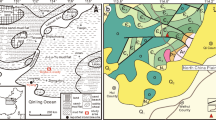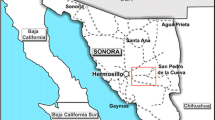Abstract
The Quaternary sediments of Lake Magadi in the Kenya Rift include large volumes of chert. Before their lithification, these siliceous sediments underwent very strong deformation, as recorded by diapirism with pillow-chert mounds, extrusion along dykes and fault ramps, horizontal liquefaction slides with brecciation, slumping, as well as petee-, flow- and shear structures. Eugster (1969) considered these structures to have resulted from desiccation of Na-silicate precipitates (magadiite) that were deposited over wide areas and were several metres thick. Magadiite can remain soft over long periods; therefore, these “Magadi-type cherts” are called the type examples of inorganic cherts. However, field observations and microbiological studies of the cherts show that real inorganic cherts are rare at the type locality of Magadi-type cherts. Most of the cherts are older than the High Magadi Beds and developed from flat-topped calcareous bioherms of Pleurocapsa, Gloecocapsa, and other coccoid cyanobacteria, thinly bedded filamentous microbial mats, stromatolites, bacterial slimes, diatoms, Dascladiacea colonies and other organic matter. Silicification occurred from a silicasol via opal-A to opal-C with final recrystallisation to a chert of quartzine composition. The metabolic processes of cyanobacteria controlled the pH and influenced the dissolution–precipitation mechanism. Collapse, liquefaction and extrusion of the pre-lithified siliceous matrix was caused by seismotectonic rift activity, which activated fault scarplets and large-scale dyke systems. It led to liquefaction and other earthquake-induced structures along the fault ramps and on tilted blocks. Concentrated silicasols were generated by the interaction of alkaline waters with volcanic detritus, coupled with biochemical processes. After liquefaction and extrusion, the material solidified by spontaneous crystallisation in an environment that was characterised by highly variable pH and salinity. The Lake Magadi basin is a remarkable example of sedimentation in a continuously seismotectonically active basin. This paper presents a first description of the micro-organisms in Magadi-type cherts, the silicification process, and the deformation that occurred still in the putty-like state before lithification.
Similar content being viewed by others
Author information
Authors and Affiliations
Additional information
Received: 1 November 1998 · Accepted: 13 September 1999
Rights and permissions
About this article
Cite this article
Behr, HJ., Röhricht, C. Record of seismotectonic events in siliceous cyanobacterial sediments (Magadi cherts), Lake Magadi, Kenya. Int Journ Earth Sciences 89, 268–283 (2000). https://doi.org/10.1007/s005319900070
Issue Date:
DOI: https://doi.org/10.1007/s005319900070




